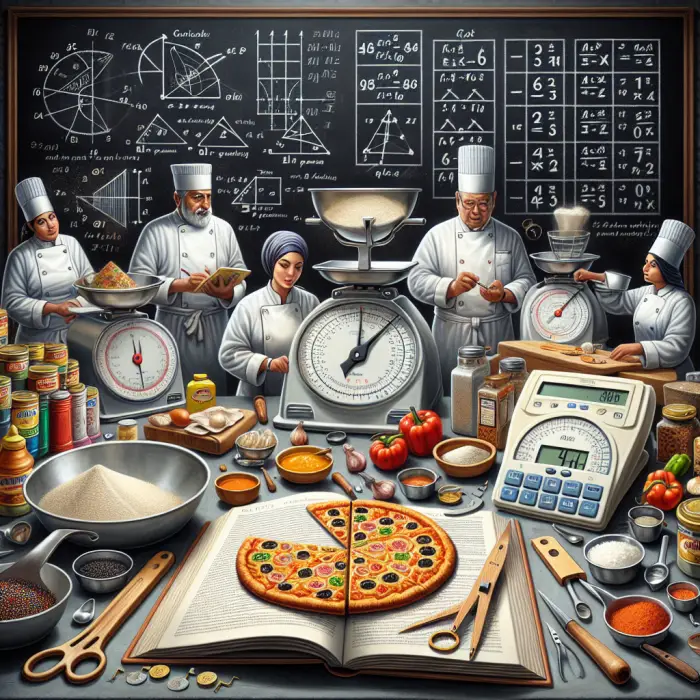
Description of culinary art’s maths, metrics, and weights in the photo.
In the world of culinary arts, numbers and measurements hold the key to creating delectable dishes. From portion counting to budgeting, culinary math is the secret ingredient that chefs rely on to ensure precision in their craft.
Whether it’s scaling recipes or calculating plate costs, a solid grasp of math operations and ratios is essential for culinary professionals.
The Metric System
Picture this: a chef effortlessly measuring ingredients with precision using the metric system. In the culinary arts, the metric system reigns supreme for its accuracy and consistency.
These units provide a standardized way to measure weight, volume, and length from kilograms to milliliters. Understanding the metric system is like having a secret weapon for precise calculations in the kitchen.
Importance of Weights
Weights are the unsung heroes of the culinary world, ensuring consistency and accuracy in every dish. When it comes to measuring ingredients like flour and sugar, weight measurements trump volume for their precision.
In baking, where every gram counts, relying on weight measurements is the key to perfecting that coveted recipe.
Recipe Conversion and Measurement Conversions
Have you ever found yourself needing to adjust a recipe to fit the occasion? Recipe conversion and measurement conversions come to the rescue.
With a recipe conversion factor in hand, chefs can easily scale recipes up or down while maintaining the right proportions. Converting measurements may sound daunting, but it’s a crucial skill for ensuring the right ingredients in the right quantities.
Edible Portion and Waste Management
In the world of culinary arts, waste not, want not. Considering the edible portion and managing waste is not just about sustainability—it’s about smart cost management.
By understanding the difference between as-purchased and edible portion quantities, chefs can minimize waste and maximize their resources, all while creating delicious dishes.
Get ready to dive into the world of culinary arts, where math, metrics, and weights are the unsung heroes behind every mouth-watering creation.
From precise calculations to waste management strategies, this blog post will take you on a journey through the intricate world of culinary math.
So grab your apron and let’s explore the delicious intersection of numbers and flavors in the culinary arts.
The Metric System
Embracing Precision with the Metric System
In the culinary arts, precision is everything. That’s where the metric system comes in, offering chefs a reliable way to measure ingredients with accuracy.
From kilograms to milliliters, these standardized units ensure that every dish is crafted with meticulous care. Say goodbye to guesswork and hello to precise calculations in the kitchen.
Unlocking the Power of Measurement Units
Picture a chef confidently measuring out ingredients, effortlessly converting between units like a culinary wizard.
With the metric system at their fingertips, culinary professionals can easily navigate weight, volume, and length measurements. Kilograms, grams, liters, and milliliters become their trusty companions in the pursuit of culinary perfection.
A World of Consistency and Clarity
In the fast-paced world of culinary arts, consistency is key. By embracing the metric system, chefs can ensure that their recipes are not only delicious but also consistently accurate.
No more second-guessing or approximating—these units provide a clear and consistent way to measure ingredients, making every dish a masterpiece of precision.
Precision in Every Pour
Imagine pouring out the exact amount of liquid needed for a recipe, with the confidence that comes from mastering the metric system.
Whether it’s a liter of broth or a milliliter of vanilla extract, these units allow chefs to pour with precision and confidence. Say goodbye to eye-balling measurements and hello to a world of exactitude in every pour.
Importance of Weights
When it comes to culinary arts, precision is paramount, and weights play a crucial role in achieving that perfection. Measuring ingredients by weight ensures consistency and accuracy in every dish, especially when it comes to dry ingredients like flour and sugar.
By relying on weight measurements rather than volume, chefs can guarantee that their recipes turn out just right every time.
In baking, where every gram can make a difference, using weight measurements is particularly important for achieving the desired outcome.
Different ingredients have different densities, so measuring by weight considers these variations to ensure that the final product is as delicious as intended.
While volume measurements are commonly used for liquids, weight measurements provide a level of accuracy that can truly elevate a chef’s culinary creations.
To excel in the culinary world, mastering the art of precise measurements through weights is essential. By understanding the importance of weight in cooking, chefs can ensure consistency in their dishes and elevate the quality of their culinary creations.
So the next time you’re in the kitchen, remember that weights are not just numbers on a scale—they’re the key to unlocking the full potential of your culinary skills.
Recipe Conversion and Measurement Conversions
Are you ever in a situation where a recipe calls for a specific quantity, but you need to adjust it to fit your needs? Recipe conversion and measurement conversions are the culinary magician’s tricks that can save the day.
By mastering the art of recipe conversion factors (RCF), chefs can effortlessly scale recipes up or down while maintaining the perfect balance of flavors and ingredients.
When it comes to measurement conversions, precision is key. Imagine having a recipe that requires 500 grams of flour, but you only have a 1-kilogram bag on hand.
Converting measurements is all about ensuring you have the right amount of each ingredient to create that mouth-watering dish.
Whether it’s converting between grams and kilograms or milliliters and liters, understanding measurement conversions is essential for culinary success.
In the world of culinary arts, every ingredient matters, and every measurement counts. By mastering measurement conversions, chefs can confidently navigate the kitchen, ensuring that each dish is prepared with precision and accuracy.
So the next time you find yourself needing to adjust a recipe or determine purchase quantities, remember that measurement conversions are your secret weapon for culinary excellence.
To put it simply, recipe conversion and measurement conversions are the unsung heroes of the culinary world. They allow chefs to flex their creative muscles, adapt recipes to fit any occasion, and ensure that each dish is a masterpiece of precision and flavor.
So embrace the magic of recipe conversion factors and measurement conversions, and let your culinary creations shine with the perfect balance of ingredients and proportions.
Edible Portion and Waste Management
In the world of culinary arts, waste not, want not. Considering the edible portion and managing waste is not just about sustainability—it’s about smart cost management.
By understanding the difference between as-purchased and edible portion quantities, chefs can minimize waste and maximize their resources, all while creating delicious dishes.
Conclusion
In the realm of culinary arts, numbers and measurements are more than just tools—they are the foundation of precision and excellence.
From mastering the metric system to embracing the importance of weights, culinary professionals rely on math to create culinary masterpieces. Recipe conversions and waste management strategies are essential skills that ensure efficiency and sustainability in the kitchen.
So next time you step into the culinary world, remember that math, metrics, and weights are the unsung heroes behind every mouth-watering creation. Embrace the intersection of numbers and flavors, and let your culinary creations shine with precision and perfection.
FAQ
What is culinary math and why is it important?
Culinary math involves using numbers and measurements in the kitchen to ensure precision in cooking. It is crucial for chefs to accurately measure ingredients, scale recipes, and manage costs effectively.
Why is the metric system preferred in culinary arts?
The metric system is preferred in culinary arts for its accuracy and consistency. Chefs can easily measure weight, volume, and length using standardized units like kilograms and milliliters, leading to precise calculations in the kitchen.
Why are weights important in cooking?
Weights are essential in cooking for their accuracy and consistency. When measuring ingredients like flour and sugar, weight measurements ensure precise amounts are used, especially in baking where every gram matters.
How can chefs convert recipes and measurements effectively?
Chefs can convert recipes and measurements by using conversion factors to scale recipes up or down while maintaining the correct proportions. This skill is essential for adjusting recipes to fit different occasions and ensuring the right ingredients in the right quantities.
Why is waste management important in culinary arts?
Waste management is crucial in culinary arts for minimizing waste and maximizing resources. By understanding the difference between as-purchased and edible portions, chefs can reduce costs and create delicious dishes efficiently.
